
A Caesar salad is a green salad of romaine lettuce and croutons dressed with lemon juice, olive oil, eggs or egg yolks, Worcestershire sauce, anchovies, garlic, Dijon mustard, Parmesan cheese, and black pepper.
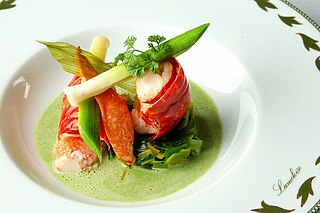
French cuisine is the cooking traditions and practices from France. In the 14th century, Guillaume Tirel, a court chef known as "Taillevent", wrote Le Viandier, one of the earliest recipe collections of medieval France. In the 17th century, chefs François Pierre La Varenne and Marie-Antoine Carême spearheaded movements that shifted French cooking away from its foreign influences and developed France's own indigenous style.

A salad is a dish consisting of mixed ingredients, frequently vegetables. They are typically served chilled or at room temperature, though some can be served warm. Condiments and salad dressings, which exist in a variety of flavors, are often used to enhance a salad.

Coleslaw, also known as cole slaw, or simply as slaw, is a side dish consisting primarily of finely shredded raw cabbage with a salad dressing or condiment, commonly either vinaigrette or mayonnaise. This dish originated in the Netherlands in the 18th century. Coleslaw prepared with vinaigrette may benefit from the long lifespan granted by pickling.
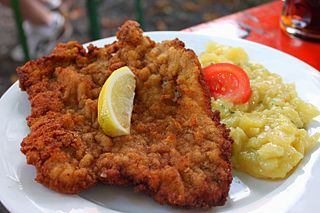
A schnitzel is a thin slice of meat. The meat is usually thinned by pounding with a meat tenderizer. Most commonly, the meat is breaded before frying. Breaded schnitzel is popular in many countries and is made using veal, pork, chicken, mutton, beef, or turkey. Schnitzel originates in Austria as wiener schnitzel and is very similar to dishes such as escalope in France and Spain, panado in Portugal, tonkatsu in Japan, cotoletta in Italy, kotlet schabowy in Poland, řízek in Czech Republic, milanesa in Latin America, chuleta valluna in Colombia, chicken chop in Malaysia, and chicken-fried steak and pork tenderloin of the United States.
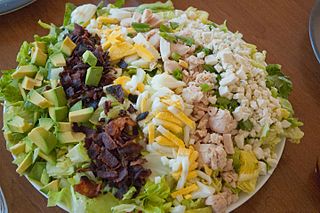
The Cobb salad is an American garden salad typically made with chopped salad greens, tomato, bacon, chicken breast, hard-boiled eggs, avocado, chives, blue cheese and red wine vinaigrette. The ingredients are laid out on a plate in neat rows. It is served as a main course.

Vichyssoise is a soup made of cooked and puréed leeks, potatoes, onions and cream. It is served chilled and garnished with chopped chives. It was invented in the first quarter of the 20th century by Louis Diat, a French-born cook working as head chef of the Ritz-Carlton Hotel in New York.
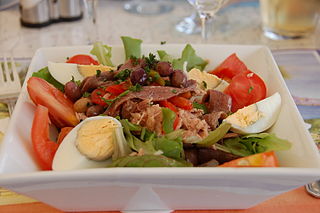
Salade niçoise is a salad that originated in the French city of Nice. It is traditionally made of tomatoes, hard-boiled eggs, Niçoise olives and anchovies or tuna, dressed with olive oil, or in some historical versions, a vinaigrette. It has been popular worldwide since the early 20th century, and has been prepared and discussed by many chefs. Delia Smith called it "one of the best combinations of salad ingredients ever invented" and Gordon Ramsay said that "it must be the finest summer salad of all".

Spinach salad is a salad with spinach as its main ingredient. In the US, a version dressed in a hot bacon dressing which slightly wilts the spinach was popular in the 1970s and into the 1980s and has been called the classic version.

Chinese chicken salad is a salad including chopped chicken and Chinese culinary ingredients that is common in parts of the United States. Though many variations exist, common features of Chinese chicken salads include lettuce, cabbage, carrots, cucumbers, chicken, deep-fried wonton skins or rice vermicelli and nuts. A basic vinaigrette for the salad includes ingredients like vegetable oil, sesame oil, rice vinegar. Optional seasonings include dry hot mustard, sesame seeds, coriander and raw ginger or pickled ginger. In restaurants, Chinese chicken salad may be more embellished and offered as an American-style entree salad, similar to Caesar, Chef, and Cobb salads.

Crab Louie salad, also known as Crab Louis salad or the King of Salads, is a type of salad featuring crab meat. The recipe dates back to the early 1900s and originates on the West Coast of the United States.
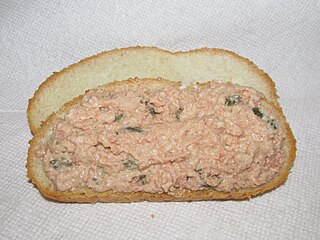
Ham salad is a traditional Anglo-American salad. Ham salad resembles chicken salad, egg salad, and tuna salad : the primary ingredient, ham, is mixed with smaller amounts of chopped vegetables or relishes, and the whole is bound with liberal amounts of a mayonnaise, salad cream, or other similar style of salad dressing, such as Miracle Whip.

Seven-layer salad is an American dish that includes a colorful combination of seven layers of ingredients: iceberg lettuce, tomatoes, cucumbers, onions, sweet peas, hard-boiled eggs, sharp cheddar cheese, and bacon pieces. The salad is topped with a mayonnaise-based dressing and sometimes sour cream is added. It is often served in a glass bowl or large pan so the layers can be observed. The dish is often associated with potlucks, picnics, and barbecues, where a large gathering of people takes place and many people need to be fed. There are many variants of the seven-layer salad and it can be made with additional layers, making it an eight-layer salad instead.

Louis Felix Diat was a French-American chef and culinary writer. It is also believed that he created vichyssoise soup during his time at the Ritz-Carlton.

Olivier salad is a traditional salad dish of Russian cuisine. Its creation is generally attributed to Lucien Olivier.

Thousand Island dressing is an American salad dressing and condiment based on mayonnaise that can include olive oil, lemon juice, orange juice, paprika, Worcestershire sauce, mustard, vinegar, cream, chili sauce, tomato purée, and ketchup or Tabasco sauce. It also typically contains finely chopped ingredients, which can include pickles, onions, bell peppers, green olives, hard-boiled egg, parsley, pimento, chives, garlic, or chopped nuts.

Salads that are internationally known as Thai salads with a few exceptions fall into four main preparation methods. In Thai cuisine these are called yam, tam, lap and phla. A few other dishes can also be regarded as being a salad.

Shopska salad is a cold salad popular throughout Southeastern Europe. It is Bulgaria's most famous salad and national dish.
Boiled dressing is a type of creamy salad dressing of English and German origin that was especially popular in the 19th century and early 20th century as an alternative to mayonnaise, which is of French origin. Boiled dressing is easier for less skilled cooks to make from scratch, and liquid food oils needed to make mayonnaise were not readily available in Northern Europe and the United States in the 19th century. Mayonnaise was not available for retail purchase until 1912.






















